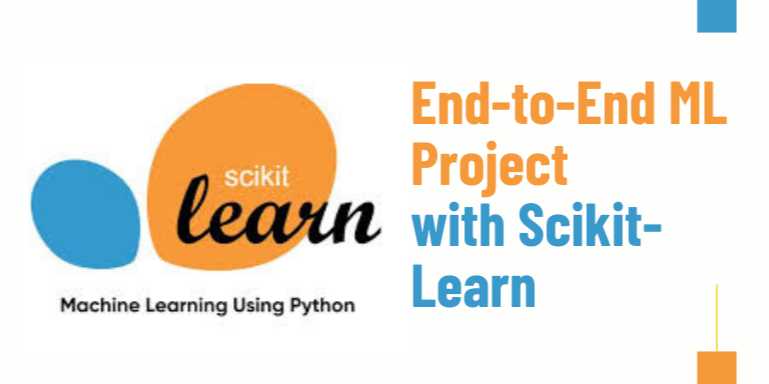A Complete End-to-End Machine Learning Project with Scikit-Learn

📖 Chapter 3: Preprocessing, Feature Engineering & Pipelines
🧠 Introduction
Preprocessing and feature engineering are among the most
crucial phases in the machine learning workflow. Models are only as good as the
data they receive — and that data must be clean, consistent, informative,
and properly transformed. Poorly prepared data leads to poor
generalization, no matter how advanced your algorithm.
In this chapter, we’ll dive deep into how to preprocess data
and engineer features using Scikit-Learn. We’ll also explore how to build
robust and reusable pipelines to automate your ML workflow — ensuring
consistency, reducing errors, and enabling efficient deployment.
🔧 1. Understanding Data
Preprocessing
📌 What is Preprocessing?
Preprocessing transforms raw input data into a clean,
standardized format that models can interpret. It involves dealing with:
- Missing
values
- Categorical
data
- Feature
scaling
- Data
types and consistency
- Imbalanced
classes
🚀 Why It Matters:
- Reduces
noise and variability
- Improves
model accuracy and speed
- Ensures
reproducibility and avoids data leakage
🧹 2. Handling Missing
Data
Scikit-Learn offers SimpleImputer and KNNImputer for
replacing missing values.
🔧 Example Using
SimpleImputer:
python
from
sklearn.impute import SimpleImputer
imputer
= SimpleImputer(strategy='median')
X_clean
= imputer.fit_transform(X)
📊 Table: Imputation
Strategies
|
Strategy |
Use Case |
|
Mean |
Normally distributed
features |
|
Median |
Skewed data |
|
Most frequent |
Categorical variables |
|
Constant |
Special value
like 0 or "none" |
🏷️ 3. Encoding
Categorical Variables
📌 Why Encode?
Most ML algorithms work only with numbers. Categorical
features need to be encoded into numeric form.
🔑 Scikit-Learn Options:
- OneHotEncoder:
For nominal data (no order)
- OrdinalEncoder:
For ordinal data (ordered categories)
python
from
sklearn.preprocessing import OneHotEncoder
encoder
= OneHotEncoder(sparse=False)
X_encoded
= encoder.fit_transform(X[['gender']])
🔁 Mapping Categories
Manually
For ordinal variables:
python
size_map
= {'Small': 1, 'Medium': 2, 'Large': 3}
df['size']
= df['size'].map(size_map)
📊 Table: Encoding
Techniques
|
Method |
Use Case |
Scikit-Learn Class |
|
Label Encoding |
Ordinal, small
categories |
OrdinalEncoder |
|
One-Hot Encoding |
Nominal,
multiple classes |
OneHotEncoder |
|
Binary Encoding |
High cardinality
features |
Use category_encoders |
📐 4. Feature Scaling
Algorithms like KNN, SVM, and gradient descent benefit from feature
scaling. It brings all features to the same scale to ensure fair weightage.
🔧 Scikit-Learn Options:
- StandardScaler:
Zero mean and unit variance
- MinMaxScaler:
Rescales to [0, 1]
- RobustScaler:
Resistant to outliers
python
from
sklearn.preprocessing import StandardScaler
scaler
= StandardScaler()
X_scaled
= scaler.fit_transform(X)
🧠 5. Feature Engineering
Feature engineering involves creating new features from
existing data to improve model performance.
🔑 Techniques:
- Interaction
terms
- Polynomial
features
- Datetime
decomposition (year, month, day, weekday)
- Domain-specific
ratios
- Log
transforms for skewed data
python
from
sklearn.preprocessing import PolynomialFeatures
poly
= PolynomialFeatures(degree=2, include_bias=False)
X_poly
= poly.fit_transform(X)
📊 Table: Feature
Engineering Techniques
|
Technique |
Purpose |
|
Binning |
Convert continuous to
categories |
|
Polynomial features |
Model
non-linear relationships |
|
Feature
decomposition |
Break compound
features |
|
Log/Box-Cox transforms |
Normalize
skewed distributions |
|
Aggregated features |
Summarize groups or
time windows |
🧰 6. ColumnTransformer:
Targeted Preprocessing
When you need to apply different transformations to
different feature types, ColumnTransformer comes in handy.
python
from
sklearn.compose import ColumnTransformer
from
sklearn.pipeline import Pipeline
from
sklearn.impute import SimpleImputer
from
sklearn.preprocessing import OneHotEncoder, StandardScaler
num_features
= ['age', 'salary']
cat_features
= ['gender', 'region']
preprocessor
= ColumnTransformer([
('num', Pipeline([
('imputer',
SimpleImputer(strategy='median')),
('scaler', StandardScaler())
]), num_features),
('cat', Pipeline([
('imputer',
SimpleImputer(strategy='most_frequent')),
('encoder',
OneHotEncoder(handle_unknown='ignore'))
]), cat_features)
])
🏗️ 7. Building Reusable Pipelines
Scikit-Learn's Pipeline class allows you to encapsulate an
entire workflow: preprocessing + modeling. This reduces data leakage and makes
the process reproducible.
🔧 Full Example:
python
from
sklearn.pipeline import Pipeline
from
sklearn.ensemble import RandomForestClassifier
clf_pipeline
= Pipeline([
('preprocessing', preprocessor),
('classifier', RandomForestClassifier())
])
clf_pipeline.fit(X_train,
y_train)
✅ Benefits of Using Pipelines:
- Fewer
lines of code
- Automatic
application of all steps
- Reduced
risk of data leakage
- Easier
hyperparameter tuning with GridSearchCV
🔄 8. Saving and Reloading
Pipelines
You can save your full pipeline for reuse in production
using joblib.
python
import
joblib
joblib.dump(clf_pipeline,
'model_pipeline.pkl')
# Later
clf_loaded
= joblib.load('model_pipeline.pkl')
🧾 Summary Table:
Scikit-Learn Preprocessing Toolkit
|
Task |
Tool/Class |
|
Missing values |
SimpleImputer,
KNNImputer |
|
Scaling |
StandardScaler,
MinMaxScaler |
|
Encoding categoricals |
OneHotEncoder,
OrdinalEncoder |
|
Creating features |
PolynomialFeatures,
FunctionTransformer |
|
Targeted transforms |
ColumnTransformer |
|
Pipeline management |
Pipeline |
|
Model persistence |
joblib, pickle |
💡 Conclusion
Preprocessing and feature engineering are the foundation of
any successful ML model. Scikit-Learn provides one of the most elegant and
modular systems for handling this part of the workflow — especially when
combined with Pipeline and ColumnTransformer.
By embracing a systematic approach:
- You
improve model accuracy
- Reduce
development time
- Ensure
reproducibility
- Prevent
data leakage
In the next chapter, we’ll explore model selection,
evaluation, and hyperparameter tuning, the stage where data meets
algorithm.
FAQs
1. What is meant by an end-to-end machine learning project?
An end-to-end machine learning project includes all stages of development, from defining the problem and gathering data to training, evaluating, and deploying the model in a real-world environment.
2. Why should I use Scikit-Learn for an end-to-end ML project?
Scikit-Learn is widely adopted due to its simplicity, clean API, and comprehensive set of tools for data preprocessing, modeling, evaluation, and tuning, making it ideal for full ML workflows.
3. Can I use Scikit-Learn for deep learning projects?
Scikit-Learn is not designed for deep learning. For such use cases, you should use frameworks like TensorFlow or PyTorch. However, Scikit-Learn is perfect for classical ML tasks like classification, regression, and clustering.
4. How do I handle missing values using Scikit-Learn?
You can use SimpleImputer from sklearn.impute to fill in missing values with mean, median, or most frequent values as part of a pipeline.
5. What is the advantage of using a pipeline in Scikit-Learn?
Pipelines help you bundle preprocessing and modeling steps together, ensuring consistency during training and testing and reducing the chance of data leakage.
6. How can I evaluate my model’s performance properly?
You should split your data into training and test sets or use cross-validation to assess performance. Scikit-Learn offers metrics like accuracy, F1-score, RMSE, and R² depending on the task.
7. Is it possible to deploy Scikit-Learn models into production?
Yes, models trained with Scikit-Learn can be serialized using joblib or pickle and deployed using tools like Flask, FastAPI, or cloud services such as AWS and Google Cloud.
8. What is cross-validation and why is it useful?
Cross-validation is a method of splitting the data into multiple folds to ensure the model generalizes well. It helps detect overfitting and gives a more reliable performance estimate.
9. How do I tune hyperparameters with Scikit-Learn?
You can use GridSearchCV or RandomizedSearchCV to automate hyperparameter tuning and select the best model configuration based on performance metrics.
10. Can Scikit-Learn handle categorical variables?
Yes, using transformers like OneHotEncoder or OrdinalEncoder, and integrating them within a ColumnTransformer, Scikit-Learn can preprocess both categorical and numerical features efficiently.
Tutorials are for educational purposes only, with no guarantees of comprehensiveness or error-free content; TuteeHUB disclaims liability for outcomes from reliance on the materials, recommending verification with official sources for critical applications.
Explore Other Libraries
Please allow ads on our site
Kindly log in to use this feature. We’ll take you to the login page automatically.
Login
Join Our Community Today
Ready to take your education and career to the next level? Register today and join our growing community of learners and professionals.

Your experience on this site will be improved by allowing cookies. Read Cookie Policy
Your experience on this site will be improved by allowing cookies. Read Cookie Policy
Comments(2)